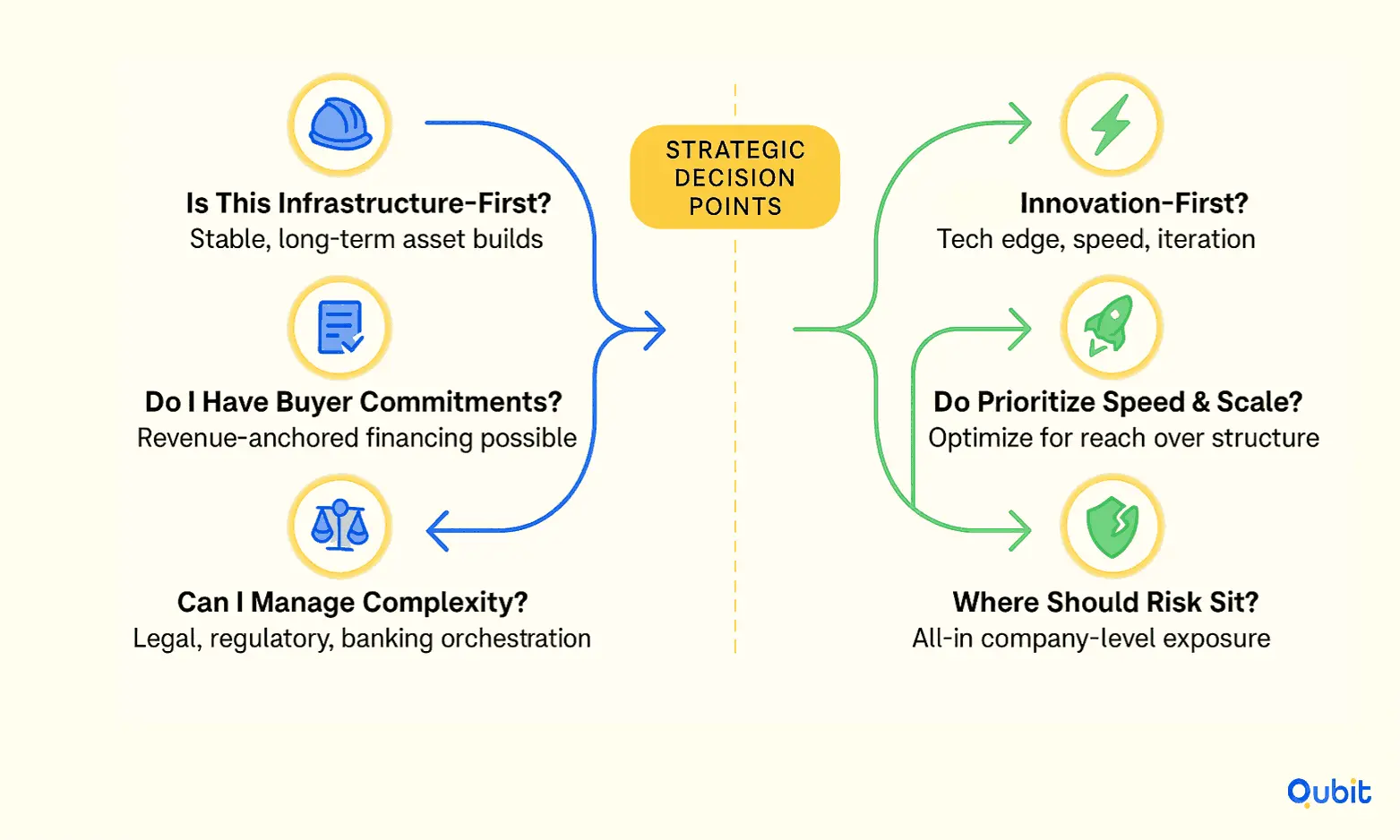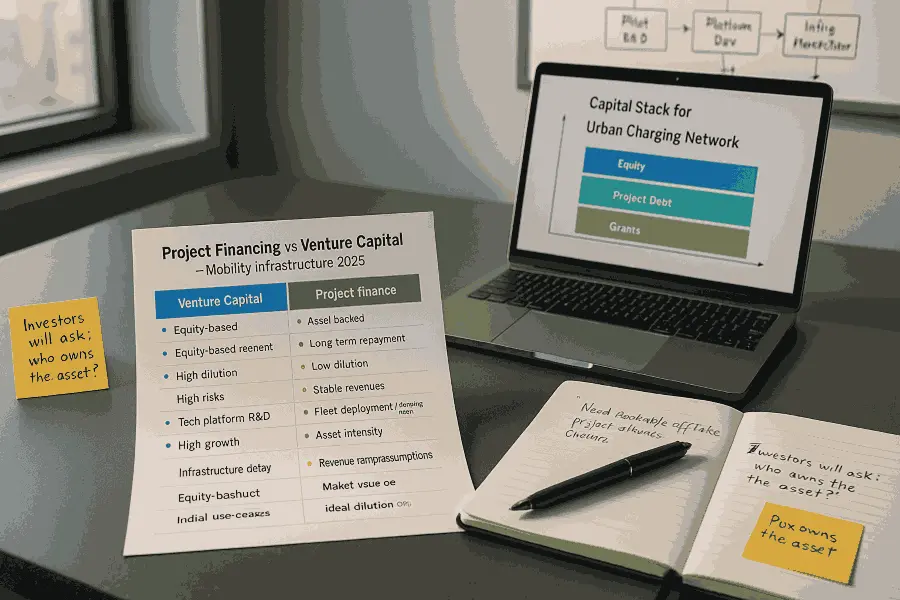Mobility startups today confront a complex financing landscape driven by unprecedented capital needs and a spectrum of diverse funding options. From the construction of state-of-the-art electric vehicle manufacturing facilities to the deployment of advanced fleet management platforms, the modalities of financing can be pivotal to a company’s growth trajectory and eventual success.
Among these options, project financing and venture capital stand out as two fundamentally distinct approaches, each with inherent strengths, risks, and applications. Understanding these mechanisms is essential for founders seeking to optimize their capital structure and align financial partners with their vision and developmental stage.
What Is Project Financing? Who Uses It in Mobility?
Project finance is the backbone of traditional infrastructure: think power plants, toll roads, and telecom towers. In the context of mobility, it’s now powering the rollout of EV charging stations, battery swap depots, large-scale logistics hubs, and mobility-as-a-service (MaaS) platforms with physical assets.
- Structure: Funding is raised within a Special Purpose Vehicle (SPV)—a legal entity created solely for the project. The project, not the parent company, is responsible for repaying lenders and investors.
- Repayment: Lenders and equity providers are paid back from the project’s future cash flows—typically contracted payments, fixed customer fees, or long-term offtake agreements.
- Risk: The project carries the risk, not (usually) the founder’s company. If things go wrong, losses are largely contained to the SPV.
Example:
A startup building a citywide e-bus charging depot can use project finance: they win a municipal contract, secure multi-year service payments, and raise debt via an SPV. If the city doesn’t pay, investors have recourse to that asset—not the parent’s other new business lines.
Pros of Project Financing
- Non-dilutive: Uses debt and limited equity—founders keep more company ownership.
- Ring-fenced risk: If the project fails, it doesn’t sink your whole startup.
- Attracts conservative capital: Banks, infrastructure funds, and insurance companies are open to long-term, contract-backed revenue.
Cons of Project Financing
- Complex structuring: Legal and financial set-up is time- and resource-intensive.
- Requires revenue visibility: No long-term contracts or “minimum guarantees”? It’s hard to raise.
- Not for pure software/innovation: If the venture relies on rapid iteration or uncertain demand, project finance is rarely a fit.
2. What Is Venture Capital? When Does It Fit Mobility?
Venture capital (VC) is the default for high-growth, innovation-driven businesses—classic startup fuel. In mobility, VC backs everything from routing algorithms and fleet SaaS platforms to autonomous vehicle startups and robotics hardware.
- Structure: Investors buy equity—generally taking minority stakes with voting provisions, board rights, and future participation options.
- Return: Investors make money on exits (acquisitions, IPOs)—not regular payouts or debt coupons.
- Risk: High-risk, high-upside: VC expects many failures for the chance of “moonshots.”
Example:
A telematics SaaS platform that enables predictive fleet maintenance raises a $3M seed round from a venture fund. The fund wants the company to aggressively scale users, iterate the product, and aim for a $500M+ valuation exit—not just hit break-even.
Pros of Venture Capital
- Rapid scale: Capital supports fast market expansion, talent acquisition, and R&D.
- Operational/journey mentorship: Many VCs provide networks, advice, and recruitment help.
- Risk tolerance: Supports uncertain, unproven business models—not just “low-risk” infrastructure.
Cons of Venture Capital
Loss of control: Board seats, reserved matters, and frequent check-ins may limit founder freedom.
Dilution: Every round chips away at founder ownership.
Pressure: Investors want rapid growth, high valuation step-ups, and will push hard for short-term targets.
Comparing Project Finance and Venture Capital
The fundamental difference between project finance and venture capital investment lies in the source of risk, method of repayment, and impact on ownership. Project finance leverages cash flows generated by the project itself, typically via a ring-fenced SPV, to pay back lenders and deliver returns to sponsors. The risk is isolated to the project’s performance, if it fails, recovery is generally limited to the project’s assets.
With venture capital, investors are directly backing the company as a whole—betting on its ability to innovate, scale, and generate enterprise value. Repayments are achieved not through specific revenue streams, but via capital gains on successful exits. This exposes investors (and founders) to higher risk and reward but entails dilution of ownership and increased oversight.
| Feature | Project Finance | Venture Capital |
|---|---|---|
| Typical Use | Infrastructure, assets, large fixed projects | Software, platforms, R&D |
| Repayment Source | Project cash flows (contracts, fees) | Company value at exit (IPO/M&A) |
| Risk Containment | Failure limited to project/SPV | Company-wide—full risk exposure |
| Capital Providers | Banks, infra funds, insurance | VCs, angel investors, PE, CVCs |
| Dilution | Generally lower; more debt | Higher; multiple equity rounds |
| Timeline to Fund | Months; complex due diligence | Weeks to months |
| Revenue Predictability | Essential | Optional; high growth trumps certainty |
| Founder Autonomy | Higher—but may be limited in project ops | Lower; investors have voting rights |
| Good for Pure Innovation? | Rarely | Absolutely |
| Good for Mature Assets? | Yes | Sometimes, but less common |
When Is Each Financing Model Appropriate?
Project Finance: Best Fit For…
- Charging station rollouts, battery swap hubs, depot construction with clear long-term contracts.
- Mobility public-private partnerships (PPP): city bus or BRT networks, bike-share infrastructure.
- Fleet leasing ventures: where large buyers/itineraries are set in advance.
- Mobility platforms “bundling” core infrastructure with service contracts (e.g., guaranteed payments from a transit agency).
Key Requirement: You must show predictable, contractually guaranteed (or highly likely) revenues to win non-recourse loans or asset-focused equity.
Venture Capital: Best Fit For…
- SaaS logistics, data marketplaces, fleet telematics, on-demand platform models.
- Startups where innovation is faster than regulation or where product-market fit is unproven.
- R&D-heavy businesses: autonomy, robotics, next-gen sensors, and deep tech.
- Early-stage, go-to-market, and blitzscaling phases.
Key Requirement: Investors need a vision for scale; demonstration of traction, but not guaranteed contracts or minimum revenues.
Blending Both: Hybrid Capital Stacks
Many modern mobility startups use both approaches in series, or even in parallel:
Example: Use infra loans to deploy hardware (buses, batteries), then raise VC to build the software or platform on top.
Example: Build your first EV charging installment with VC; finance subsequent city builds with project finance once anchor contracts are secured.
“Founder’s Lens”: Choosing, Negotiating, and Sequencing Capital

Questions Founders Should Ask
- Is my venture infrastructure-first, innovation-first, or a hybrid?
- Do I have the commitment (or will I soon have) from buyers/customers to offer future revenue certainty?
- What’s my appetite for complexity, can I assemble lawyers, bankers, and regulatory experts needed for project finance?
- Am I optimizing for control and asset separation—or for speed, risk, and massive market capture?
- Where do I want the risk to sit: isolated project loss (project finance) or company-wide “all-in” risk (VC)?
Sequencing Advice
For capital-intensive, regulated markets (urban transit, national mobility grid), always plan legal and financial structuring far in advance, retrofits are expensive.
Use VC for speed, early-market capture, and R&D-heavy sprints; graduate to project finance as your business matures and can offer stable contracts/assets.
Don’t box yourself in early, structure company and project entities to allow future SPVs (this matters for mobility, where city/region-specific projects can be hived off).
Communicate openly with investors about the intended capital stack; sophisticated VCs appreciate that not everything can run off pure equity.
Common Pitfalls (and How to Avoid Them)
- Misapplying VC to asset-heavy builds: Founders who use expensive VC money for infrastructure risk heavy dilution and eventual loss of control.
- Underestimating project finance complexity: Negotiating with banks, city planners, and multiple legal stakeholders can stall launches for a year or more.
- Relying on “guaranteed” revenue before contracts are signed: Don’t pitch project finance on “likely” but unsecured deals.
- Ignoring venture timelines: VC investors expect liquidity in 5–7 years. Don’t overcomplicate your venture with SPVs that could dissuade later acquirers or IPOs.
Practical Scenarios in Mobility
- EV Charging Network: Early pilots financed with grants or angel capital, followed by project finance for national scale-up, using secured utility-hosted contracts.
- Telematics SaaS: VC for platform build-out, then (optionally) project finance for proprietary hardware devices/edge sensors once large fleet orders are secured.
- Integrated Mobility Platform: Early VC for software (app, routing, payments); city-specific SPVs/project finance for station infrastructure, vehicles, or MaaS hardware.
Conclusion
In the evolving world of mobility, where capital intensity and innovation collide, understanding the mechanics, trade-offs, and alignment of project finance and venture capital is vital. Each financing path brings distinct advantages—whether hedging project risk through asset-based funding or accelerating growth with venture backing—and specific challenges that test founder preparation and adaptability. The strongest mobility companies approach their financing strategically: weighing technical requirements, revenue predictability, stage, and risk tolerance against the demands and benefits of each capital source.
Founders who prepare early, communicate clearly, build robust project documentation, and seek guidance from corporate advisors and sector specialists will not only enhance their chances of securing the right kind of investment but will also set the stage for resilient, scalable growth in a competitive market. Our Fundraising Assistance service is designed to help you achieve your goals. Let’s get started today!
Key Takeaways
- Project finance is non-dilutive, asset-focused, and suits infrastructure plays with predictable, contract-based revenue.
- Venture capital is high-risk, equity-driven, and best for rapid innovation, early-stage blitzscaling, and software/platform businesses in mobility.
- **Choosing wrong can mean excessive dilution, slow launches, or being “blacklisted” by later-stage capital providers.
- Most successful mobility growth journeys mix both: VC early for speed, project finance at scale for capital efficiency.
- Planning for both models means structuring your cap table, legal, and project entities early—avoid “painted into a corner” scenarios.
Frequently asked Questions
What are the main risks of project finance in mobility?
Legal complexity, upfront costs, time to close, and risk that major contracts fall through, leaving lenders exposed and the project under-resourced.






